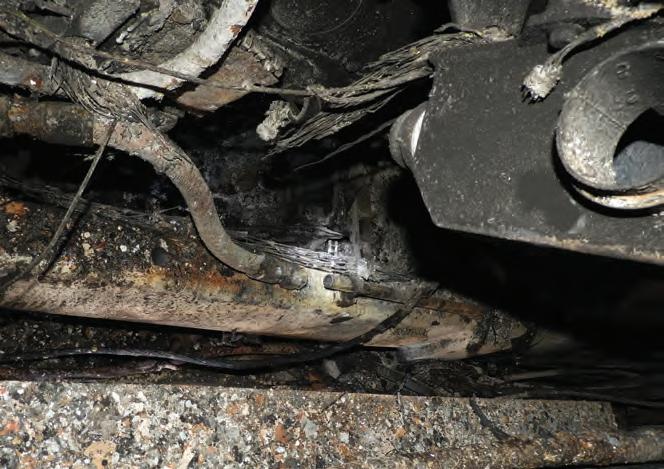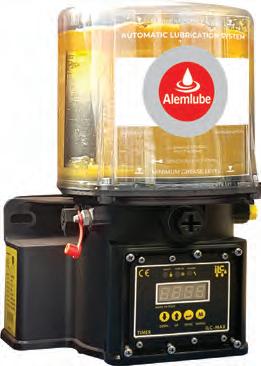
4 minute read
Fire Forensics defeats electrical fires
Defeating electrical fires with Fire Forensics
FUEL-DRIVEN FIRES ARE ONE THING, ELECTRICAL FIRES ARE ANOTHER. FIRE FORENSICS SENIOR INVESTIGATOR VICKY DAYALAN EXPLAINS HOW MINING COMPANIES CAN SAVE LIVES AND MONEY WITH REGULAR MAINTENANCE.
The mining industry is inherently driven by combustible stimulants.
While electrification is the way of the future, many mining vehicles operate on diesel, while incidental inflammables are omnipresent at a mine site – minerals, expended rubber, tyres, wood, debris and more.
Fuel is one source of a mine-related fire, but there are also electrical means associated with things like motor discharge, static electricity discharge, earthing faults or the presence of highvoltage power cables.
Fire Forensics senior investigator Vicky Dayalan tends to many electrical fires on mine sites – accidents many workers don’t anticipate.
“Electrical fires are one of the largest causes of fires on mine sites,” Dayalan says.
“If it’s not fuel-related, it’s usually electrically related. It’s usually when the equipment is being used or energised, so you might have an operator in a haul truck and sometimes there’s not even any indication on the dash – there’s no signal given to the operator that something has gone wrong and the only thing that will alert them is flames.”
With more than 40 years of experience behind the company, Fire Forensics has forged a reputation for its astute understanding of arguably the world’s most dangerous adversary.
It’s the company’s passion and obligation to arrive on site to determine how and why a blaze occurred.
Electrical fires often have common causes, with parts either being misused or reaching the end of their tether.
“Electrical fires are normally due to general wear-and-tear or maintenance. Or it could be because a temporary fix has been used and so they’ve got to substitute parts when they can’t get the authorised part to use,” Dayalan says.
“If you’re using something that didn’t actually come with the equipment, technically it’s not meant to be used, and there’s a reason why - because it wasn’t designed to be used for that vehicle or equipment.”
Dayalan has seen many miningrelated electrical fires caused by loose cabling.
“We’ve investigated quite a few mine site fires, and the electrical ones are usually because wiring or cabling hasn’t been restrained properly, so it’s not actually fitting nicely. If it comes loose and then rubs onto a hose or another cable, over time that friction will obviously wear out the other cable or hose,” she says.
“That then can lead to a fluid leak or create a high-resistance pathway that causes localised heating which will then lead to ignition of the hose or the cable

Preventing electrical fires is vital to improving worker safety and averting serious injury. If a fire is not fuel-related, it’s usually electrically related.
which is quite dangerous. If it’s a fuel hose, the fire spreads faster. If it was another cable it would be a lot slower because it would smolder.”
Fires remain a concern for mining operations. According to 2019 data from insurance company FM Global, in the five years leading up to the report, fire accounted for 27 per cent of all losses on mine sites worldwide.
Between September 2014 and May 2017, the New South Wales Resources Regulator reported more than 200 fires on New South Wales mine sites – double the incidents that occurred between 2001 and 2008.
While these statistics look beyond just electrical fires, there’s enough merit to solidify the overarching significance of the issue.
To ensure worker safety and prevent more electrical fires occurring on mine sites, Dayalan says one ingredient is more important than all else.
“As long as they (mining operations) are doing the routine maintenance, they’re not cutting corners, they’re using appropriate things to fix any issue, or appropriate material to fix any issue, and not just putting a cable tie on something to restrain it,” she says.
“It’s mainly just maintenance. I know maintenance is a huge thing and everyone keeps talking about it, but it’s critical.
“If there’s anything missing or you can see a bit of cabling is not restrained properly you can actually go in and quickly fix it, and that simple action can save the machine, and most of these machines are in the millions and millions of dollars.”
Mining operations should also consider completing regular risk assessments of their assets to prevent electrical fires.
Understanding potential electrical fire scenarios, the consequences an electrical fire could impose on the operations and the real probabilities of an electrical fire happening, are safety checks mining operations should implement on a regular basis.
Mine sites comprise some of the most valuable assets in the world, and it is not just about the minerals.
Preventing electrical fires is vital to improving worker safety and averting serious injury, but also for the preservation of prized machinery and equipment.
An electrical fire typically occurs when equipment is being used or is energised.

THINK PROCESS SAFETY?

Think Alemlube Fixed Plant Automatic Lubrication Systems.











